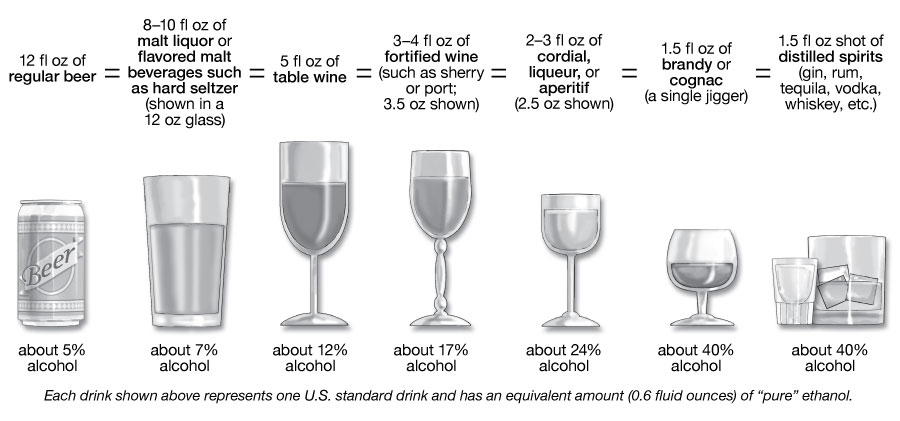If you or someone you know is in crisis, Dial 988 then Press 1.
If you or someone you know is in crisis, Dial 988 then Press 1.
What is Considered a “Standard” Drink?
If you drink alcohol, you may consider the number of drinks you’ve had to be the number of glasses of wine or bottles of beer you have had. The actual way to determine how many drinks you’ve had is by how much alcohol is in each glass.
In the United States, one “standard” drink (what counts as one alcoholic drink) contains roughly 14 grams of pure alcohol, which can be found in:
If you already knew this, that’s wonderful, but keep reading! You might learn something new. If you didn’t know the answer, you are not alone. Many people don’t know what counts as “a drink”.
Important Factors to Consider when Drinking
The amount of alcohol contained in a drink – commonly measured by Alcohol by Volume (ABV) – can vary widely depending on what type of alcoholic beverage you are having. The alcohol content in different types of beer, wine or malt liquor can be different, so you can’t always tell how much alcohol is in your drink based on the amount of liquid in your glass, can or bottle. It’s important to know how much alcohol your drink contains by considering the size of the drink, the type(s) of alcohol used in the drink and the percent alcohol contained in each of the type(s) of alcohol.
For example, “regular” beers (beers that are mass-produced) typically have around 5% alcohol while many other beers, like “craft” beers (beers made with real malts and higher-quality ingredients), can have about twice as much alcohol. Keep in mind, drinking a light beer may not mean you are consuming significantly less alcohol. Many light beers contain around 4% alcohol content – almost as much alcohol as regular beer.
The National Institute on Alcohol Abuse and Alcoholism (NIAAA) provides some great examples in the illustration below of one standard drink that contains roughly 14 grams of pure alcohol:

Factors Impacting How the Same Amount of Alcohol may Impact Individuals Differently and the Rate at which a Person Surpasses the Legal Drinking Limit
There are many different factors that can affect how alcohol is absorbed and processed in the body. This affects a person’s level and rate of intoxication. How fast a person’s Blood Alcohol Concentration (BAC) – measured by the weight of the alcohol in a certain volume of blood – rises varies based on several factors, including:
At a BAC of .08 grams of alcohol per deciliter (g/dL) of blood, car crash risk increases greatly. Because of this risk, it is illegal in all 50 states, the District of Columbia and Puerto Rico to drive with a BAC of .08 or higher, except in Utah where the BAC limit is .05.
If you or someone you know is in crisis, Dial 988 then Press 1.